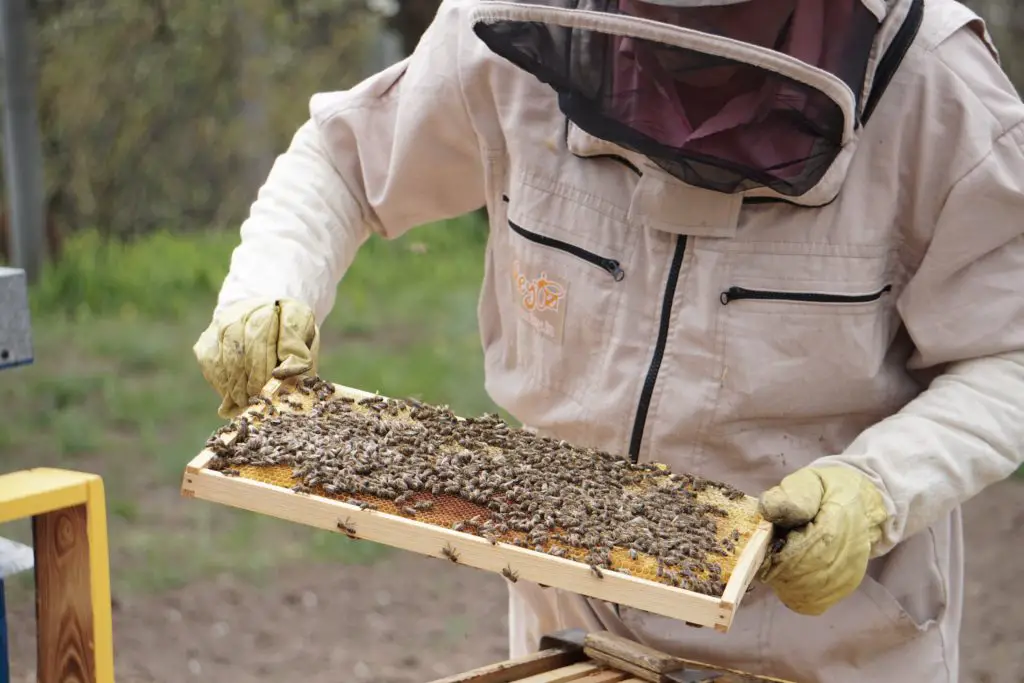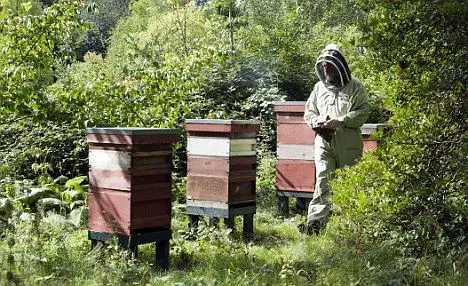Affiliate Disclaimer - As an Amazon Associate I earn from qualifying purchases.
It supports the website. So, Thank you
Bees are active during the summer and when cold weather comes around, they will enter into a state of dormancy. This means that you need to prepare the hive to keep the bees safe and save yourself a lot of maintenance the following spring.
Among other things, you’ll need to protect the hive from rodent visitors. During winter, mice and other small rodents will be attracted to your hive for shelter and warmth. While they’re definitely got the right idea, you don’t want them hiding out in there.
So the best thing to do is to create a mouse guard that’ll prevent mice from getting in. This guard needs to have holes to allow ventilation but what is the correct beehive mouse guard hole size?
Each of the ventilation holes should measure 8mm. However, a lot of commercially sold mouse guards come with 10mm holes, but there is a suggestion that some smaller mice can squash themselves down to get into holes of this size.
If you’re getting your hive ready for winter then a mouse guard is a must. In this guide, I’ll discuss the right-sized hole as well as give you some other tips and advice on making and installing your guard.
Table of Contents
What Is A Mouse Guard?
A beehive mouse guard is a simple yet essential piece of equipment. You use it to cover the entrance of your beehive so that mice and other small critters cannot get in. However, the holes still need to be big enough to allow your bees to get in and out as they need.
Normally, mouse guards for beehives are made from metal. This material is almost impossible for a mouse to chew through so it’ll just go elsewhere.
You might decide to make your own mouse guard and it’s very simple; I’ll talk about how to do this later in this guide. Alternatively, there are mouse guards on sale at beekeeping stores and online. When buying a commercially made mouse guard, I would recommend checking the size of the holes as some of them come a little too large which defeats the entire object of the guard in the first place.
Entrance Reducer and Mouse Guard for 8 or 10 Frame Bee Hive, Used for Beekeeping with No-Rust, Universal Stainless Steel Metal Design for Winter and Year Around, 4-Pack
$34.99
HunterBee 5/10 Pack Beehive Entrance Reducer 8 Frame bee Hives Mouse Entrance Guard Adjustable bee hive mice Guards Beekeeping Beekeeper Tools
$9.99
Mouse Guard Hole Size – Which Is Right?
Choosing the right mouse guard for your beehive is essential since mice are crafty little critters that can get through holes that just don’t seem big enough.
The mouse guards that you can buy in stores and online tend to come with 10mm holes but there’s a very good chance that a mouse could squeeze through these. Some beekeepers suggest hammering nails into the wood behind the guard to create bars which may further deter the mice but in my opinion, it’s best to just use smaller holes.
Most people will tell you that 8mm holes are sufficient for a beehive mouse guard and I am inclined to agree with this to a certain degree. The problem is that some smaller species of mice are actually able to get through gaps as small as 5mm! They can also jump up to 24cm in height but that isn’t going to affect anything in this situation; it’s just an interesting fact!
Why Do I Need A Mouse Guard For My Beehive?
Mice might be super cute but they’re no good for you bees. If a mouse decides to set up a home in your beehive then there’s a very good chance that your colony will not make it through the winter. While bees are hardy little creatures, the presence of mice is something that they can’t take. What’s more, when mice invade, they usually come in pairs which makes it even more difficult for the bees.
Mice love a warm place to hide where there’s no draft and that’s exactly what they’ll get if they manage to enter the hive. So they won’t leave without a fight. However, since they like to set up their nest and make the place their own, they will usually chew the wood of the hive and even nibble on the comb. This is devastating for the bees so you’ll need to do everything in your power to keep them out.
Making A DIY Mouseguard
While mice can be a real problem for beekeepers, the good news is that making your own beehive mouse guard is affordable and easy. You don’t need to be a DIY whizz to make a secure guard and while you can buy them in stores, DIYing allows you to customize the guard to suit the needs of your hive.
One of the best things you can use is some wire mesh. Make sure that it’s strong so that the mouse doesn’t give chewing a try. Also note that when you are working with this wire mesh, the edges can be a bit sharp so it’s best to trim them down first to make it safer and easier to handle.
Once you have trimmed the edges, it’s merely a case of securing the wire mesh to the hive, ensuring that the entrance is fully covered.
Checking For Mice
Before you install a mouse guard, you need to make sure that no mice have taken up residence already. If they have, then installing a guard could essentially trap them inside and that’ll be no good for the mouse or your bees. So it is vital not to skip this step.
Things You’ll Need
To make your own DIY mouse guard, you’ll only need some simple tools:
- Protective gear for yourself
- A hive tool
- A smoker
- A flashlight
- A stick or a wire hanger
If possible, have another person to help you check for rodent visitors as it can be tricky to do by yourself. Although if you have no other choice then there are some beekeepers online that talk about using a telescopic pole and a mirror to check the hive without a second person.
However, if you can rope in help from a friend or family member then it will be a lot easier. One of you will need to take the hive tool to get the bottom board away from the hive. When they’ve done this, they’ll need to tilt the hive back. Do keep in mind that the hive will be pretty heavy at this time of the year as they will be rammed with honey so make sure the person doing the lifting is strong enough to manage up to 260lbs.
Once the hive is tilted back with the bottom board out of the way, the second person will use the flashlight to take a look inside. Be sure to wear a veil when you do this and be thorough in your investigations. Mice could be hiding in the space underneath the frames or over the bottom board. It’s also important, where possible, to shine your flashlight so that you can see between the combs as mice have a tendency to hide here when they feel threatened.
In most cases, you won’t find anything; as long as you are checking early enough in the season. However, if you are unfortunate enough to find a mouse then you’ll need to get rid of them. In most cases, they’ll run away without any interference from you because they’ll be scared. If they don’t, that’s where your stick comes in which you can use to force them out.
When Is The Best Time To Install Mouse Guards?
Most people aim to install their mouse guards around September. The weather usually starts getting a little cooler at this time of year and it’s good to get into the habit of making preparations before winter sets in. This is because, while it might not yet be super cold, little animals like mice will already be on the hunt for somewhere to hole up so you need to stay one step ahead of them.
Conclusion
Mice are a serious problem for beekeepers because once they invade a hive, it’ll be incredibly difficult for the colony to survive if the intruder isn’t quickly evicted. The problem is that you’re not supposed to keep opening the hive in winter so it can be very difficult to know if there are any mice.
But using a mouse guard will prevent rodents from getting in in the first place and keep your bees happy and safe over winter. However, since mice can get through very small holes, you’ll need to know the right beehive mouse guard hole size.
Something around 8mm should be small enough to stop mice from getting in while still allowing the bees in and out. That said, some smaller mice will still be able to fit through this gap so 5mm may be preferable if there are very small species in your area.







